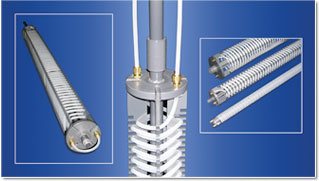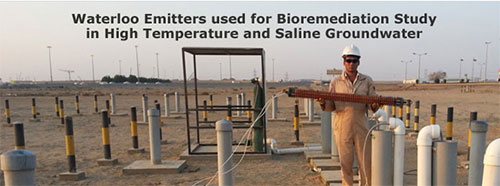
Engineered for the Controlled Continuous Diffusive Release of:
- Oxygen for aerobic bioremediation
- Hydrogen for anaerobic bioremediation
- CO2 for pH adjustment
- SF6, He, Ar for tracer tests

Overview

The Waterloo Emitter™ is designed to assist in-situ remedial biodegradation of MTBE, BTEX and other contaminants. It enables oxygen (or hydrogen for anaerobic remediation) to diffuse through silicone or LDPE tubing in a controlled uniform manner. The simple, low-cost, patented technology consists of a PVC frame wrapped with tubing that can be pressurized to obtain the desired diffusive transfer of gas, appropriate to site-specific needs. Sized for 2", 4" and 6" (50, 100 and 150 mm) wells, the units can be stacked in a well and joined from one well to another, to allow the controlled continuous diffusion of gas into the plume.

Waterloo Emitters used for Bioremediation Study in High Temperature and Saline Groundwater:
A study was undertaken to determine the success for aerobic bioremediation of aromatic hydrocarbons (BTEX) and MTBE (methyl tert-butyl ether) in high temperature, saline groundwater conditions. The study included laboratory microcosm experiments, as well as a field trial in Saudi Arabia, in which Solinst Waterloo Emitters were used.
Waterloo Emitter™

1.8", 3.8" & 5.8" Waterloo Emitters
The Waterloo Emitter is a simple, low cost device designed for the controlled and uniform release of oxygen, or other bioenhancing amendments, to encourage and sustain the growth of microorganisms required for in-situ bioremediation of contaminated groundwater.
The patented technology* enables steady, direct diffusion of oxygen into an aquifer through pressurized silicone or LDPE tubing. Continuous, consistent release of oxygen into the tubing creates the ideal concentration gradient driving this passive system, without ‘bubbling off’ excess oxygen.
Emitters are ideal for the bioremediation of BTEX and MTBE using oxygen. The diffusive process provides immediate bioavailability of molecular oxygen for aerobic biodegradation enhancement, therefore no loss of the amendment gas occurs. The Waterloo Emitter can also encourage desirable abiotic reactions (pH adjustment, hydrolysis, etc.).
With the addition of oxygen into the subsurface, microbial biodegradation of pollutants - the natural breakdown of chemical contaminants by microorganisms - is enhanced. Techniques that supplement natural attenuation processes are more commonly being used due to their ability to accelerate cleanup efforts. Using oxygen, the Waterloo Emitter has the potential to make cleanups faster, more effective, and less expensive.
Applications, Advantages and Benefits

Schematic showing staged plume remediation using Waterloo Emitters, monitored
by a transect of CMT or Waterloo Multilevel Systems placed down gradient.
If an enhancement gas is to be used for remediation, a small to medium sized gas cylinder can be used. Emitter tubing is selected and pressure is set according to the amount of enhancement gas required. A single gas cylinder can be used to supply multiple Emitters connected in series. Replenishment of the gas inside the Emitter tubing can be accommodated by periodic purging (weekly/bi-weekly), or a needle bleed valve can be used at the end of the system to allow slow, constant replenishment to occur.
Operating Principles
Waterloo Emitters are available to fit 2", 4" and 6" (50 mm, 100 mm and 150 mm) wells. They can be installed in open wells, or they can be permanently installed with sand packs in boreholes or trenches. The 51" (130 cm) long Waterloo Emitters can be installed individually or stacked one on top of another, to ensure full coverage of the contaminant plume. They are also effective in horizontal applications.
Because there is no minimum hydraulic head required, the Emitters are effective at any depth below water. When used in conjunction with packers and/or circulating pumps, the radius of influence is increased.
The Waterloo Emitter’s unique diffusive technology allows for the use of almost any chemical as an amendment to treat contaminated groundwater. The PVC frame accommodates the insertion of monitoring or sampling devices for observing groundwater conditions during the remediation process.
The Waterloo Emitter consists of silicone or polyethylene tubing coiled around a PVC frame. When a fluid is introduced into the tubing a concentration gradient is created between the inside of the tubing and the groundwater.
The Emitter works in accordance with Fick’s Law, whereby diffusion will occur until there is equilibration in chemical concentration inside and outside of the tubing. With the Emitter technology, the oxygen (or other amendment) is replenished continuously, and as groundwater continues to flow around the Emitter, equilibration never occurs. This results in continuous diffusion from the Emitter into the groundwater.
When a gas is applied to the Emitter there is a direct correlation between an increase in applied pressure and an increase in the amount of gas that will diffuse into the groundwater, however, diffusion is the only mechanism that allows the amendment to be added to the groundwater.